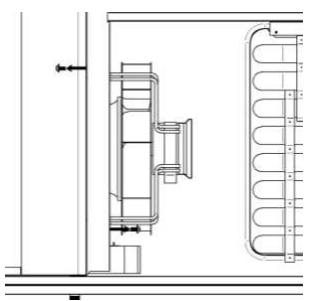AAON RQ Series Indirect Fired Heat Pump Yearly Maintenance
The AAON RQ Series Indirect Fired Heat Pump Yearly Maintenance is a standard procedure that checks the operation quality of the machines components. Be sure to follow the safety steps provided to avoid any accidents.
AAON RQ Series Indirect Fired Heat Pump Yearly Maintenance
The AAON RQ Series Indirect Fired Heat Pump Yearly Maintenance is a standard procedure that checks the operation quality of the machines components. Be sure to follow the safety steps provided to avoid any accidents.
At least once each year, a trained, qualified service technician should check out the unit. Fans, evaporator coils, and filters should be inspected at least monthly.
Gas Heating
WARNING! Once a year, before the unit is in operation for the heating season, a qualified service technician should inspect all flue product carrying areas of the furnace and main burners for continued safe operation.
DANGER! LEAK CHECK GAS PIPE The gas pipe in the unit should be checked for leaks before startup. Leak checking is the responsibility of the installing contractor. All connections should be checked for leaks annually after installation. Failure to leak che
Gas Heat Exchanger Removal
WARNING! Electric shock hazard. Shut off all electrical power to the unit to avoid shock hazard or injury from rotating parts.
DANGER! LEAK CHECK GAS PIPE The gas pipe in the unit should be checked for leaks before startup. Leak checking is the responsibility of the installing contractor. All connections should be checked for leaks annually after installation. Failure to leak che
Removal
Reinstallation
Figure 29 - Gas Heat Exchanger
DX Cooling
Condenser Fan
WARNING! Electric shock hazard. Shut off all electrical power to the unit to avoid shock hazard or injury from rotating parts.
WARNING! Improper installation, adjustment, alteration, service, or maintenance can cause property damage, personal injury, or loss of life. Startup and service must be performed by a Factory Trained Service Technician.
Removal
Figure 30 - Removal of a Condenser Fan Assembly
Reinstallation
Condensate Drain Pans
Evaporator Coil
WARNING! Electric shock hazard. Shut off all electrical power to the unit to avoid shock hazard or injury from rotating parts.
Removal
Figure 31 - Evaporator Coil Access
Reinstallation
E-Coated Coil Cleaning
WARNING! Electric shock hazard. Shut off all electrical power to the unit to avoid shock hazard or injury from rotating parts.
CAUTION! High velocity water from a pressure washer or compressed air should only be used at a very low pressure to prevent fin and/or coil damages. The force of the water or air jet may bend the fin edges and increase airside pressure drop. Reduced unit
CAUTION! Harsh chemicals, household bleach, or acid cleaners should not be used to clean outdoor or indoor e-coated coils. These cleaners can be very difficult to rinse out of the coil and can accelerate corrosion and attack the e-coating. If there is dir
Recommended Coil Cleaner
The following cleaning agent, assuming it is used in accordance with the manufacturer’s directions on the container for proper mixing and cleaning, has been approved for use on e-coated coils to remove
Enviro-Coil Concentrate, Part Number HEC01.
Recommended Chloride Remover
Remove Barrier
Apply CHLOR*RID DTS
Rinse
Microchannel Coil Cleaning
Allowed Chemical Cleaners and Procedures
WARNING! Electric shock hazard. Shut off all electrical power to the unit to avoid shock hazard or injury from rotating parts.
Simple Green
Simple Green is available from AAON Parts and Supply (Part# T10701) and is biodegradable with a neutral 6.5 pH. Recommendation is to use it at a 4 to 1 mix. Use the following procedure.
Water Flush
This procedure can be used when the only material to cause the coil to need cleaning is debris from plant material that has impinged the coil face.
CAUTION! Use pressurized clean water, with pressure not to exceed 140 psi. Nozzle should be 6” and 80° to 90° from coil face. Failure to do so could result in coil damage.
Application Examples
Other Coil Cleaners
Roofing
Supply Fan
WARNING! Electric shock hazard. Shut off all electrical power to the unit to avoid shock hazard or injury from rotating parts.
CAUTION! Blower wheels and bands must be inspected for excessive dust build up periodically and cleaned if required. Excessive dust build up on blower wheels may cause an unbalanced state; leading to vibration and/or component failure. Damages due to exce
Factory Lubrication
Note: Bearing lubrication only applies to belt driven fan motors such as the energy recovery wheel power exhaust fan motor.
Recommended greases are:
Removal
Figure 32 - 2-6 ton Supply Fan
Slide blower assembly
out of unit through blower access opening (see Figure 34).
Figure 34 - RQ Supply Fan Removal Slide
Phase and Brownout Protection Module
DPM Setup Procedure
Recommended Default Set-up
Source: Aaon

